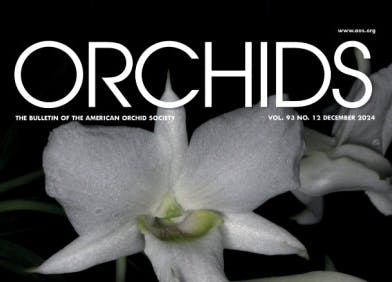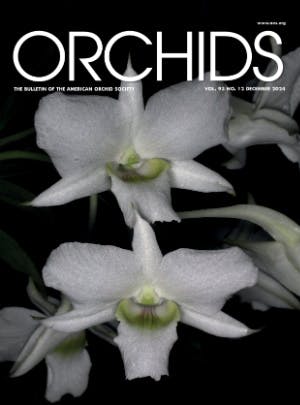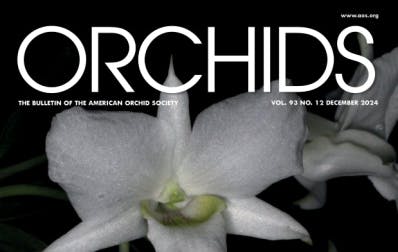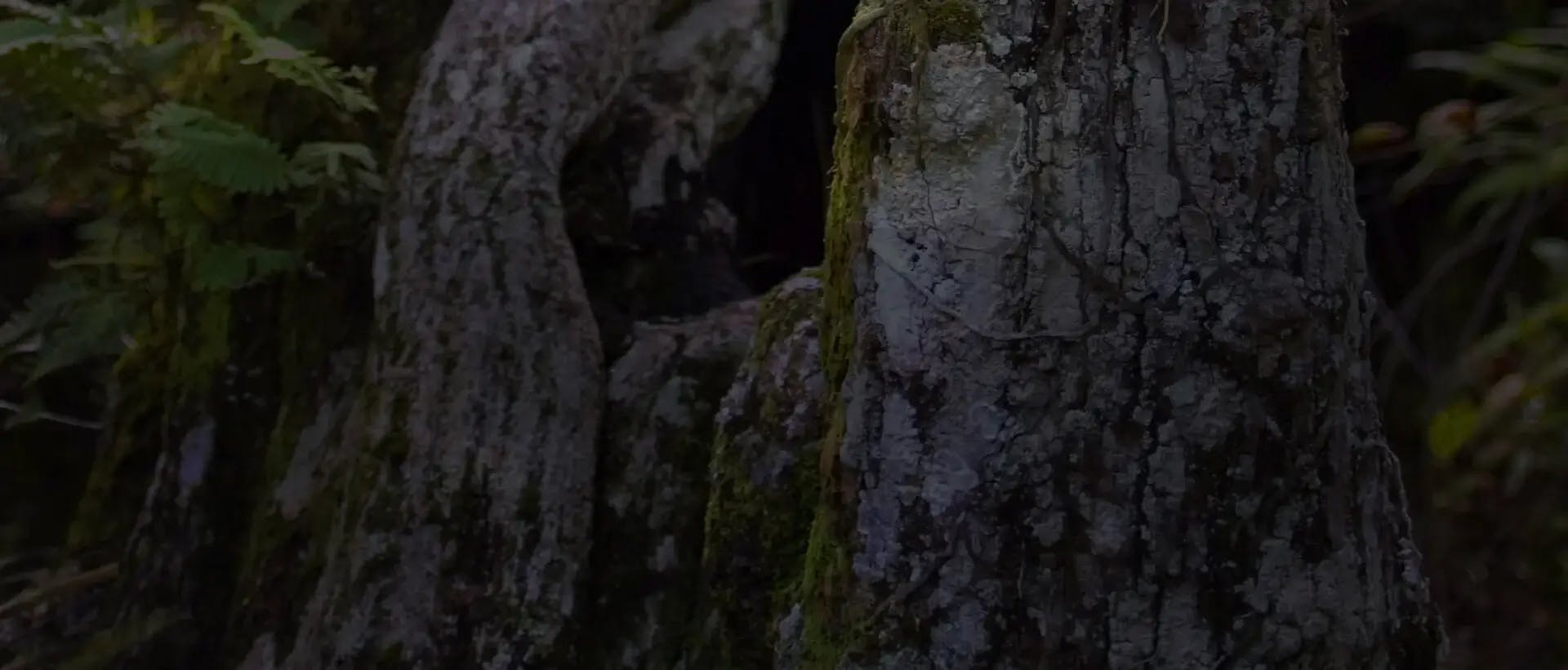
I read Sue Bottom’s (2024) article on growing habenarias with great interest. Unfortunately, it gives the impression that there is only one way to grow them. At the risk of being accused of plagiarizing myself, let me rephrase a passage from an article on habaneras that I wrote for Orchids magazine in 2018.
Once one understands the growth cycle for the genus Habenaria and its relatives (species and hybrids), they are fairly easy to grow. As mentioned above, these plants are mostly terrestrial and grow from an underground tuberoid. Let us start in the spring, when the tuberoids are beginning to sprout. They are coming out of dormancy, of which more later, and have been kept fairly dry during their rest period. Please recognize that what follows is the way I grow them. If you are growing them successfully by other methods, by all means keep doing what you have been doing. At this point, only water a little, moistening the surface of the medium once a week. As the growth elongates and begins to produce leaves, water again once a week but with more water; light feeding is good at this point too. The plants should be kept evenly moist but not sodden. Moderate light (phalaenopsis light levels), humidity, air circulation and intermediate temperatures make for good growing conditions. Sometime in mid to late summer, the plants, if mature, should flower. Enjoy! After flowering, the plants begin to die back, and you can cut back on the water but not completely. The plants should still be evenly moist. When the plants turn yellow and then brown, it is time to begin the dreaded dormancy period. Many habenarias are killed during this period, but it does not have to be so. Now, you can cut back the plant. I like to leave an inch (2.5 cm) of stem so that, when it comes to repotting, I know which end of the tuberoid is the top. Because the plants do not need light at this point in their growing cycle, you can put the pots anywhere with even, intermediate conditions, even in the dark. Usually, if the plants are kept constantly wet at this time, the tuberoids will rot (there are some exceptions, but most people will not encounter these plants). Some growers can keep their tuberoids completely dry during this period without deleterious results. If I do it, the tuberoids completely desiccate, shrivel, and die. So, once a week, I spray a mist of water over the surface of the pots (I am not watering the pots!), and this works for me to get through dormancy without killing the plants. In late January or early February, I repot my plants. (This is usually before the tuberoids have sprouted). Some growers use sphagnum moss (do not pot tight!) or soilless medium (such as Pro-mix), but I prefer my terrestrial mix (Glicenstein, 2017). I usually pot with the top of the tuberoid about ¾ of an inch (1.9 cm) below the surface of the medium. Because I have the stem that I left, I know which way is up. If it has broken off and you cannot see which end is up, plant the tuberoid horizontally. Continue treating the pots as they were treated during the dormancy period until growth begins, and then treat again as above.
[1] Habenaria Galah ‘Judy’ AM/AOS (carnea × janellhayniana) (pronounced ga-LAH). Photograph by Bryan Ramsay.

So you can see, I do not personally remove the plants from the pot during the dormancy period until I am ready to repot the dormant tuberoids. For me, I do not find that necessary. But that is up to you. Also, under my conditions, I do not use Pro-mix, even with added perlite, as it keeps my plants too wet. Instead, I prefer the terrestrial mix I presented in 2017.
4 parts seedling bark mix
6 parts #3 Perlite
2 parts small charcoal
3 parts Miracle-Gro Potting soil
1 part packed container of dry, cut up New Zealand sphagnum moss, approximately ¼-inch pieces.
[2] Pectabenaria Shima Enaga ‘Judy’ AM/AOS (Kat hawk × Habenaria medioflexa). Photograph by Bryan Ramsay.

[3] Habenaria Egret (Kakoeri × medusa); photograph by the author.
[4–5] Habenaria Bird of Paradise (Conure × medusa); photograph by the author.
[6] Habenaria Oriole (roebelenii × xanthocheila); photograph by the author.
[7] Pectabenaria Wow’s White Fairies (Pecteilis susannae × Habenaria medusa); photograph by Nam Fook Lee.
[8] Habenaria Kat’s Whiskers (lindleyana × medusa); photograph by the author.
[9] Habenaria Sunrise Plumes (roebelenii × medusa); photogaph by the author.
[10] Pectabenaria Perseus (Pecteilis hawkesiana × Habenaria medusa); photograph by the author.
[11] Pectabenaria Little Angel (Habenaria carnea × Pecteilis hawkesiana); photograph by the author.

Please note that it is in parts, not percentages, so depending upon the size of the scooping container for the components (I usually use a 5-inch [12.5 cm] flowerpot), you can make any amount of mix you want. I also try to repot the plants annually, but the medium can last two years. I do sometimes get lazy.
[12] Habenaria Bird of Paradise ‘Doctor J.’ AM/AOS (Conure × medusa) grown by
the author and photographed by Sara Hurdel.

[13] Pectabenaria Snowy Egret ‘Judy’ AM/ AOS (Perseus × Wow’s White Fairies) grown by the author and photographed by Michael Summers.

Now you can see, there is not only one way to grow habenarias, and you can choose which method or combination of methods that works for you. How we grow our plants is never stagnant, and as new media are found for growing orchids, some of my methodology may change. Also, breeders making hybrids may eventually introduce hybrids that are different enough to require changes in growing methodology. For example, they may create plants that do not go through a dormancy period and continually produce new growths so that the plants need to be moist all the time. That will make growing these plants even easier.
I hope more people will grow these attractive, colorful plants. Plant breeders are creating all sorts of flower shapes, color combinations and plant sizes for everybody’s greenhouse, underlight- growing and windowsill enjoyment.
— Leon Glicenstein (email: glicenstein33@msn.com)
References
Bottom, S. 2024. Habenarias. Orchids. 93(10):748–749. Glicenstein, L. 2017. New Pelexia olivacea Hybrids. Orchids. 86(8):586–693._. 2018. Selected Habenaria Hybrids. Orchids. 87(8):590– 597.











